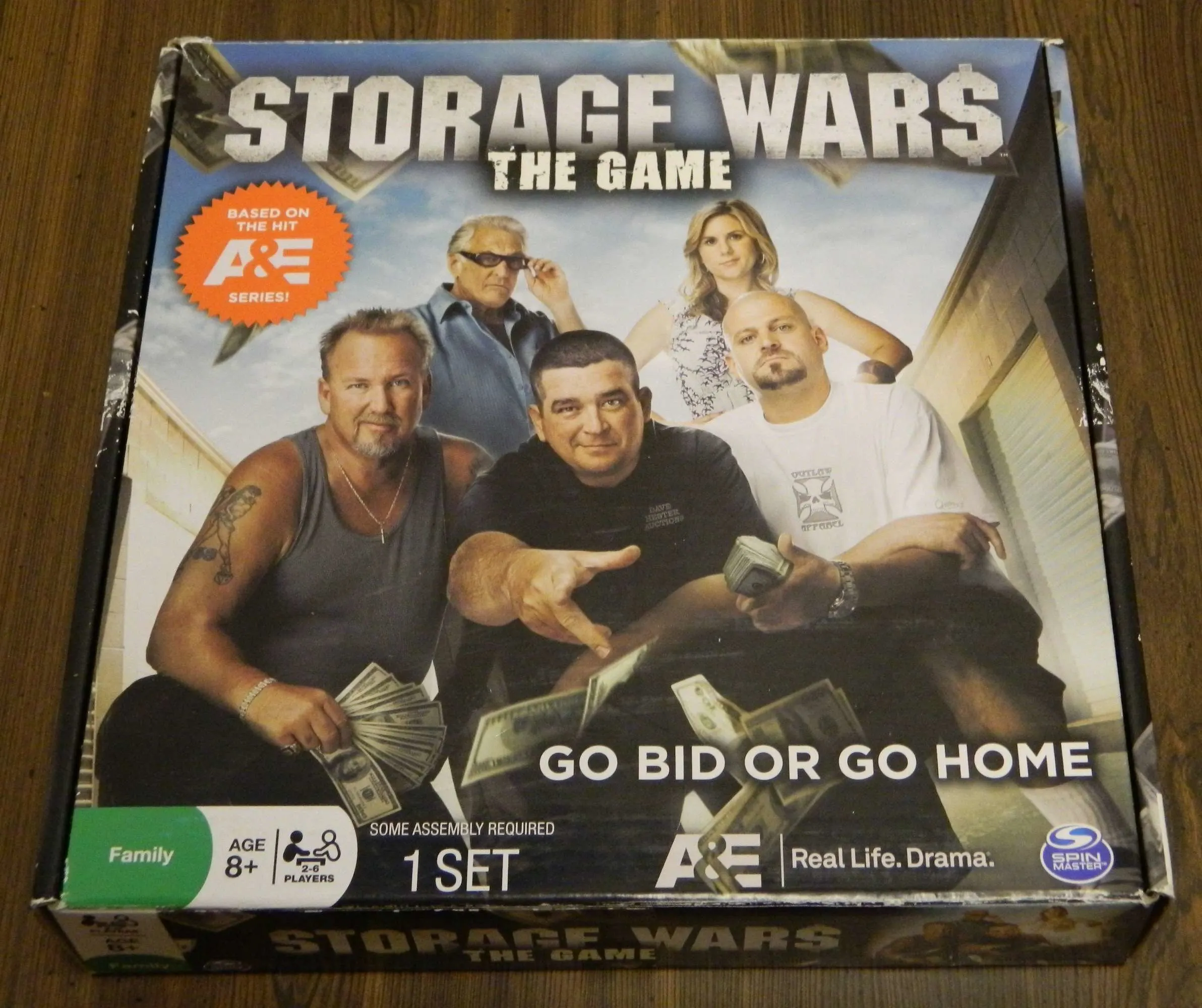How to Play
What Is Storage Wars: The Game/What Is the Object of the Game?:
Storage Wars: The Game is a 2012 auction/bidding game from Spin Master Ltd. and game developer Nick Hayes. The game obviously was an attempt to cash in on the hot television show from the early 2010’s. The object of the game is to be the player with the most money after three rounds of bidding on storage lockers.
Setup
Assemble the storage lockers and place all four of them in the center of the table. Each player chooses a player card (Dave Hester, Barry Weiss, Darrell Sheets, Brandon Sheets, Jarrod Schulz, or Brandi Passante) and gets $3000 worth of play money (three “500 dollar bills” as Darrell would say even though there is no such thing in real life, ten $100 bills, and ten $50 bills). All remaining money is used to form a bank. Finally, place all sixty item tokens in the token bag so they can be blindly drawn.
How to Play the Game:
Storage Wars: The Game lasts for three rounds (or “episodes”) of bidding. Each round, four abandoned storage lockers are available to the highest bidder. At the beginning of each round, each player draws three item tokens from the bag and looks at them (without revealing them to their opponents). The item tokens can be anything from a $100 old tool to a $2,500 safe or $3,000 classic car (or even items that hurt the buyer of the locker, I’ll get into these later). Then, like the actual show is alleged to have done players one by one “seed” the lockers by placing their tokens inside one or more of the storage lockers (so other players don’t know where you placed your tokens, I recommend that either everybody else close their eyes or look away). Players have the option of dividing their tokens in anyway that they wish to, they can place all three in the same locker and risk it all, put two tokens in the same locker and the other one in a different one, or divide them into three different lockers. No matter how you divide them, make sure to remember which locker you put your good tokens in since you will need to know which one to bid on after everyone is done filling the lockers.
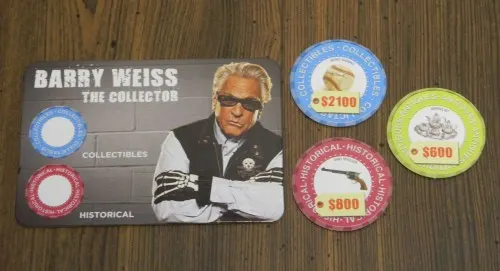
Obviously when you draw tokens you will keep them in your hand so other players can’t see what you have but this is just an example of drawing tokens. For reasons I will explain later, both the baseball and the gun are extremely valuable to this player playing as Barry (they are actually worth double their face value).
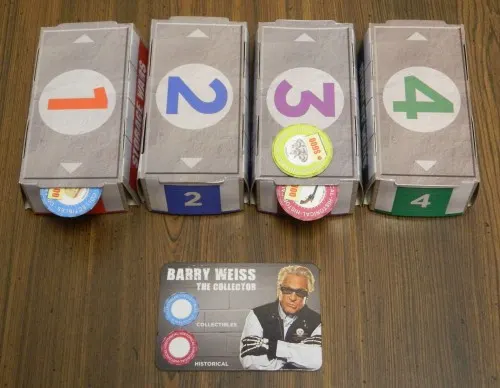
This is how the player playing as Barry decided to fill the lockers. They decided to divide their item tokens into two different lockers. Obviously, players will push the tokens all the way in but I wanted to show how you actually fill the lockers.
Once all players have seeded the lockers with goodies (or not-so-goodies), bidding begins on storage locker #1 at $50. Any player can bid at anytime and they may raise the bid by any amount they want (although since the lowest denomination bill is $50 the bids should be in $50 increments). Bidding continues until nobody chooses to raise the bid anymore. The locker is awarded to the highest bidder, they take possession of the locker (but do not open or reveal their locker until the end of the round) and “pay the lady” (I mean bank) the amount of their bid. The other lockers are then auctioned off in the same way (starting with #2, then #3, and finally #4). Players who have already won a locker can still bid on and win other lockers, you aren’t limited to just one per round and you aren’t guaranteed to get one either.
While this is obviously not advised unless it’s an emergency, if a player ever needs more money for bidding they may sell back any items they won in previous rounds (but not any tokens in lockers already won in the current round since they won’t be revealed yet) for half the item’s face value. They may do this at anytime, the rules even make it seem like you can do this in the middle of bidding.
After all four lockers in a round/episode have been sold, players open the lockers they won and reveal the item tokens that were inside. You don’t sell the items for anything just yet, you keep them in front of you and add them up once the game is over. However, you can see what you got and whether or not you got a good deal. After all of the lockers have been revealed, a new round/episode begins and it is played in the exact same way. A total of three rounds/episodes are played before the game ends.
Bonus Categories:
Each player has different types of items they are looking for. For example, just like in the show if you are playing as Barry you are looking for collectibles (blue-rimmed tokens) and historical items (purple tokens). Brandi loves antiques and furniture, etc. Any items you win that match the two bonus categories on your player card will be worth twice their face value. Thus, if you draw good items which also happen to be one of those two colors you will want to make sure you win them. If you need to sell an item to the bank to get more bidding money and the item you want to sell happens to be one of your bonus category items, the amount you get back is half the face value, not half the doubled bonus value.
Negative Items:
Some of the item tokens are actually negative tokens that hurt the value of a locker. Negative value items include things like “fake!” (which is worth -$500), “water damage!” (-$400), and “missing parts!” (-$200). There is also a very cruel negative value token called “black mold.” Any locker that contains a black mold token is now completely worthless (every item in the locker has been contaminated). If you are unlucky enough to get one of these tokens in one of your lockers, stack all item tokens (including other negative value tokens) and put the black mold token on top. You effectively paid your bid amount for a locker worth $0. Do not include any of these tokens (including the negative value ones) when you add up your total at the end of the game. Players who draw negative value tokens should obviously place them in a locker that they don’t plan on bidding on in order to hurt their opponents.
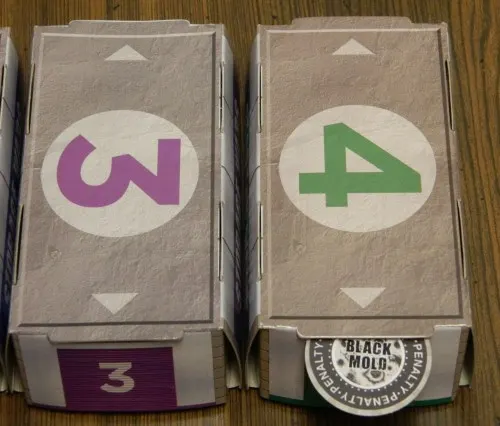
This player has a dreaded black mold token and has decided to infest the fourth locker. No matter how many other tokens are placed in this locker, the winner of it will be stuck with a locker worth $0.
Winning the Game:
After the three rounds/episodes are over, players add up their leftover cash and all tokens they won from storage lockers throughout all of the rounds. Make sure to double the value of any tokens that match the two categories (or colors) your character is looking for. Also, subtract any negative item tokens you got. The player with the most money (after selling all of their tokens) at the end of the three rounds is the winner.
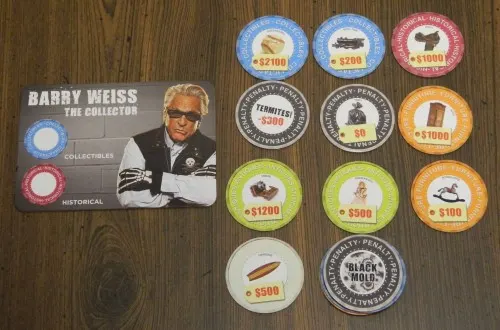
The game has ended and this is an example haul a player might wind up with. Since this player played as Barry, all blue and purple tokens are worth double their face value (so the baseball is worth a whopping $4200, the model train $400, and the saddle $2000). All of the rest of the tokens count as their face value (the termites subtracts $300 from this player’s total). Finally, this player was unlucky enough to run into a locker with black mold. All of the tokens found in that locker (which are stacked underneath) are worth $0. If a player doesn’t use all of their money, the amount left over is also added to their total (but this player decided to go full Barry and overbid on lockers and was left with no money to add to their total). This haul is worth a total of $9,600.
Review
A Surprisingly Solid (Though Unspectacular) Licensed Game:
Even though I used to be a fan of the show (but haven’t watched it in years) and love to buy cheap collectibles and sell them for a profit, I fully expected Storage Wars: The Game to suck. I learned about the game years ago but since I figured it would be terrible (even though I knew the concept of bidding on storage lockers is one that could make for a good game), I decided to wait until I found it at a thrift store for a dollar or two. I lucked out and found a copy on clearance at Goodwill (you know you are cheap when you wait for a game to hit the clearance section of a thrift store) for a dollar. After playing it, Storage Wars: The Game is nowhere near as bad as it could have been. I was expecting a licensed cash grab game that somebody designed in a day or two but it’s actually a solid game. While there aren’t a lot of mechanics, the game developer took a game I expected to be horrible and turned it into a pretty fun game.
Theme Works Pretty Well:
Except for the fact that you seed the storage lockers with items, the theme in Storage Wars: The Game works very well (and even seeding lockers makes sense if the accusations are true). Everything makes sense and the theme is perfect for an auction/bidding game. The fact that you have limited knowledge (where you placed your item tokens) makes sense since if you are at a storage auction, you will probably see a few things of value in the front (but have no idea what the majority of the items in the boxes and in the back will be). If you are a fan of Storage Wars, this is a pretty good representation of what it is actually like to bid on storage lockers. Fans of the show will obviously get the most enjoyment out of the game but if you just like to hunt for good deals at thrift stores or rummage sales, you also might enjoy it.
To add to the theme, we (briefly) role-played as the characters we were playing as. We made the Dave Hester player bid with “Yuuup!”, I played as Darrell and was constantly making up bill denominations that don’t even exist (“$400 bill, right here”), etc.
House Rules:
If I ever play Storage Wars: The Game again, I will probably play with some slightly altered rules. While the rules aren’t bad, they definitely can be improved. First of all, in four player games I wish there were more item tokens in each locker. So, in future games we will probably give each player four or five tokens each round to seed the lockers with. A lot of the tokens wound up being unused anyway so why not use them to make the auctions more exciting? Also, I think it would be very fun to add a couple random item tokens to each locker that nobody knows the identity of. Finally, I’m not sure if this would be an improvement or not, but it could be fun to pull one item out of each locker before the bidding begins (as a teaser). Obviously if it happens to be a black mold token, it will ruin the bidding but otherwise it could tempt players to bid a little bit more.
Cheap Components and Other Negatives:
I didn’t find a lot of negatives when I played Storage Wars: The Game but the biggest is the cheap components. The storage lockers are made of cheap cardboard and don’t stay together very well. The tokens are also made out of cardboard, but they are sturdy enough to play with. Finally, the art design of the game is pretty boring. I know that Storage Wars: The Game was meant to be a cheap game to sell in department stores but I do wish the components were a little better.
The only mechanics problem I found was the fact that if you draw negative value tokens (other than the black mold one), you have a pretty big disadvantage. Obviously you will know which storage lockers to avoid but knowledge of good items (especially ones that match what your character is looking for) is more important and helps you make more money. Since other players could know the location of three good items, they have a pretty large advantage over players who draw the negative value items. However, if you happen to draw one of the black mold tokens you might actually have the biggest advantage of all. While you will want to bid a little bit (to avoid suspicion), you won’t get stuck with a locker worth $0 like one of your opponents will. The black mold tokens are extremely painful to get, especially if they just happened to be placed in a locker you threw all your good tokens into. They aren’t OP but they are pretty close.
Quick and Easy to Learn and Play:
It shouldn’t be that surprising that mass market games are pretty easy to learn and play and Storage Wars: The Game definitely fits that criteria. You can easily learn how to play the game in under five minutes and even inexperienced gamers should be able to pick it up pretty easily. Games are also pretty quick to play (20-30 minutes at most) so Storage Wars: The Game works pretty well as a filler game.
Final Verdict
While I was pleasantly surprised with Storage Wars: The Game (and gave it a three out five stars), it isn’t really a phenomenal game that hardcore gamers are going to love. There are plenty of better and more strategic auction/bidding games on the market. However, is it a solid game that is good for Storage Wars fans, casual gamers, or as a game that hardcore gamers can actually play with their non-gamer family members? Yuuup! The theme works well, it is easy to learn and play, and the game is overall a pretty solid auction/bidding game. I wouldn’t pay a lot for the game but if you are looking for a casual auction/bidding game, you could do much worse than Storage Wars: The Game.

